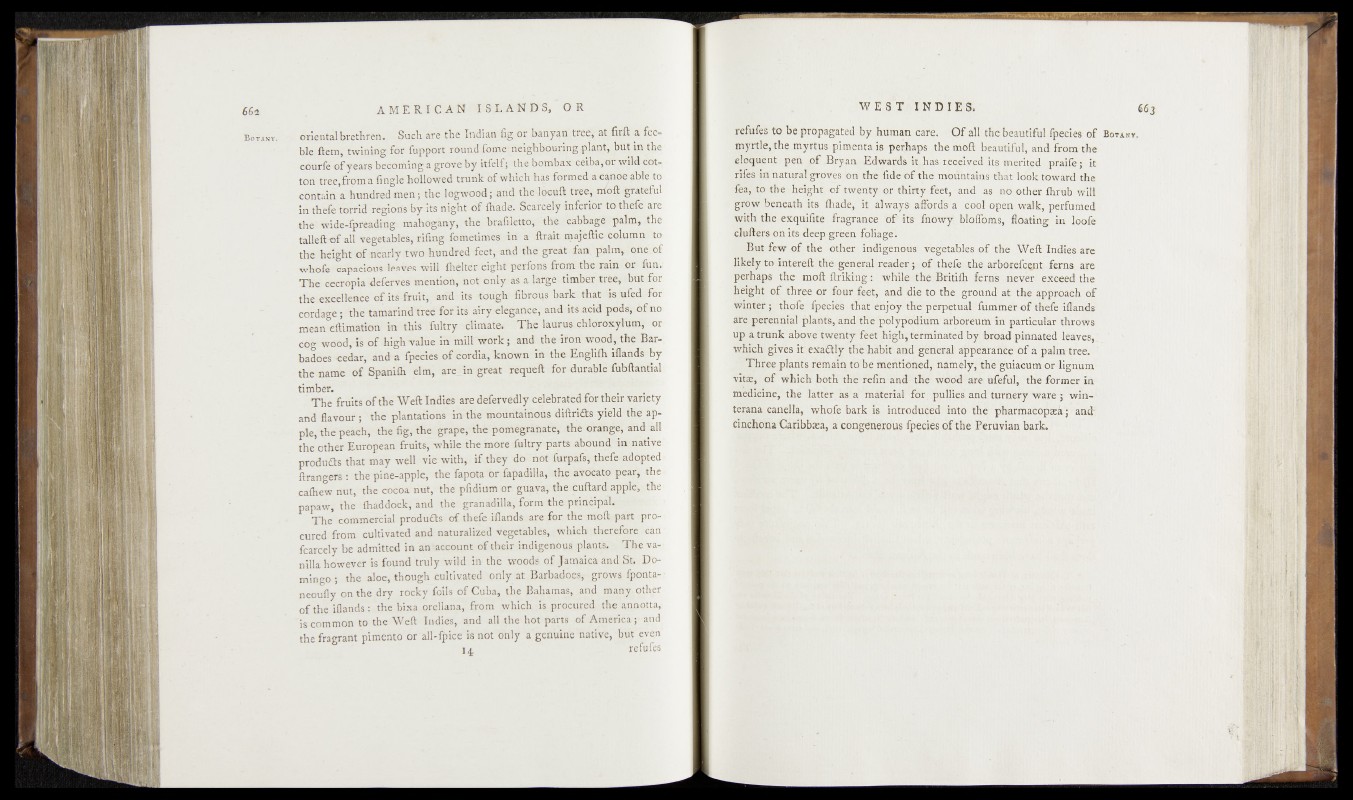
B otany, oriental brethren. Such are the Indian fig-or banyan tree,- at fitft a feeble
ftem, twining for fupport.round fomemeighbouripg .plant, but in the
cóurfé-of years becoming a grove by Mêlf;' t^he bombak- ceiba, oywilfl. cot-,
ton tree,from a Angle hollowted trunk of which has forfned a carïèe ablfto
contain a hundred men; the logwood;.and the^Jö&uft tree-,- Uioft grateful
in thefe torrid regions by its night of fliade. •-Scarcely-inferior tdth^e are
the wide-fpreadiug mahogany, the brafiletto, the cabbage palm, the
trileft-of all vegetables^ifihg fomerimes i# k teak, majeftio-col,u-mn^to
the height of nearly two hundred feet^and the great-fan palm,' q.nelof
whofe capacious leaves will fhelfereight perfonsfeoTh the rain or fun.‘
The cecropia deforces mention, not only as a large- timber tree, but for
the excellence of its-fruit, arid its tough' "fibrous bark that knifed for
cordage | ; the tamarind tree for its airy elegance, -and its acid ’.pods^efeno
mean eftimation in this fultry climate, The lauruq.cMo'rokylum, &pr
cpg wood, is of high value in milt work; and the -iron wood, the Bar-
badoes cedar, and a fpecies of cordia, known in the Englifh iflands Bby
the name of Spanifli elm, are in great requeft -for durable, tebftantial
timber.
The fruits oftheWeft Indies are defervedly celebrated for their variety
and flavour; the plantations in the mountainous diftri&s yield the ||>-
ple, the peach, the fig, the grape, the pomegranate, the orange; and all
the other European fruits, while the more fukry parts abound1 in; native
products that may well vie with, if they do'not fiirpafs, thefe*adapted-
teangers: the pine-apple, the fapota or fapadilla, ^the^ayoGatp, pear, the
cafhew nut, the cocoa nut, ïhe pfidimn or gupva, the-cuftard apple, the
papaw, the fhaddock, and the gran ad Ma, form the principal.
The commercial produ&s of thefe iflands are for the moft-part procured
from cultivated and naturalized vegetables,, which' therefore dan
fearcely be admitted in an account of their indigenous plants. The vanilla
however is found truly wild in the woods of Jamaica and St. Domingo
; the aloe, though cultivated only at Barbadoes, grows fponta-
neoufly on the dry rocky foils of Cuba, the Bahamas, and many- other
of the iflands: the bixa orellana, from which is procured the annotta,
'is common to the Weft Indies, and all the hot parts of America ; and
the fragrant pimento or all-fpice is not dtily a'genuine native, but even
14 refufes
refufes to be propagated by human Of all the beautiful fpecies of Botany.
myrtle, the myrtus pirtfjSpia is-perhaps .the thoft and from the"
eloquent? peps^pf J3ryan»-«^E^wa.r^s i tó 4s.ièèp:j^ftj|tS( nrigri^BIpraife; k
rJCes-irf natur;rif^|y|sJon' the we^of^^^iwfebis^lipylënk toward the
fea, to||?he heighfe -of tvu^nty Jj&foi^tysfoet,, ^a.nd saÉ|bctóiaer ferdh/wili
grow beneath its fhatL,„is alwaft, ^afford, a c'oalfopeu walk, terfuihed
with the exquifite fragrance ^^%’*|fe®Iv^jhirQjF§ms,, boating fo jpofe
clutters on^Js*-dee|yg;feép fofikgqfefe,
But few of the other indigenous-, jfrqggtabl^of/tlie Weft Indies.,are
] i ke% • tori n ter eft,' the -general -re ad e-r ^ efeth efe\ i og&fbap t ferns, are
perhagS tfej&t -nfoft tei^^fei^whilfiHfoe^Brki'fli ^ferns .peyen .e&a^djhe
bëights- of three or fnurfeet, and die to the -g@ md at' .t^e apbfoMhfof
winter; thofe fp'ebif^= fo’affenjoy the?pèrpêthalf'filmmer of thefe iflands
are p'erennial plants,'arid thepolypodium rirboreum in particular thrdws
up^ a trunk above twenty feet high; terminated broad pinnated leaves;,? '
which'gives it exactly the habit arid general appearafree^ofa palm tree. '
Three plants remain to be mentioned, namely, th’e'guiacum qrflignUm-
vité, of which both the refin and- the wood %rè u’fefuï,' the former in
medicine, " the latter as a material for pullie's and turnery ^k'fqy lWin--
terana canella, whofe bark is introduced into thé pfeafmacopfea; and:
cinchona Caribbaea, a congenerous fpecies of the Peruvian bark.